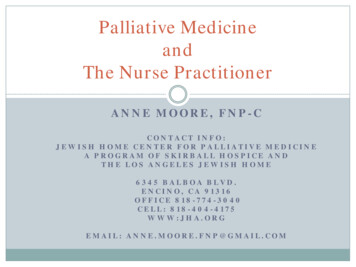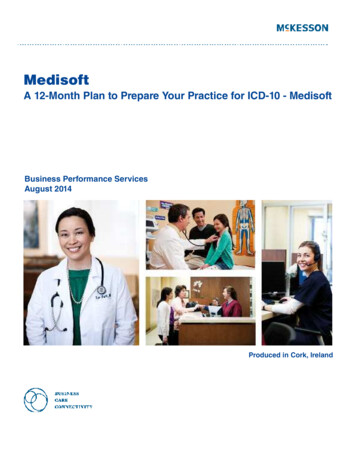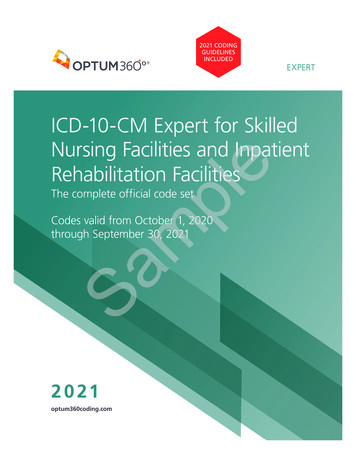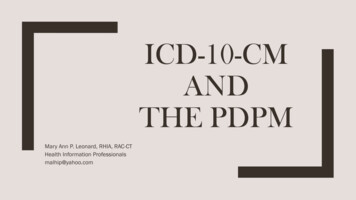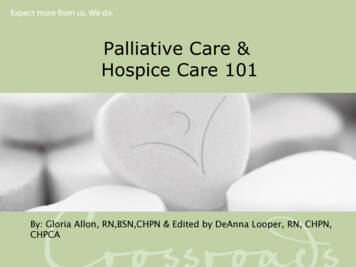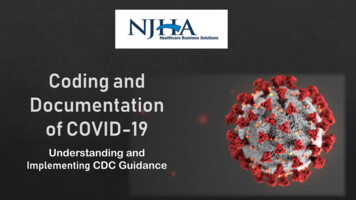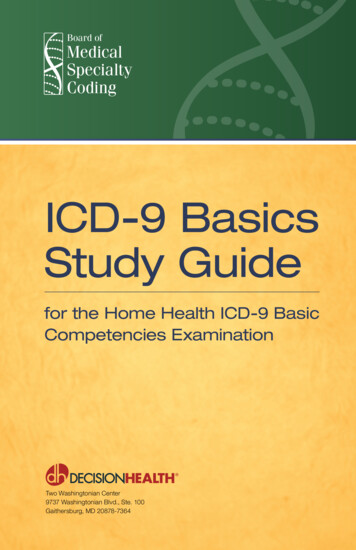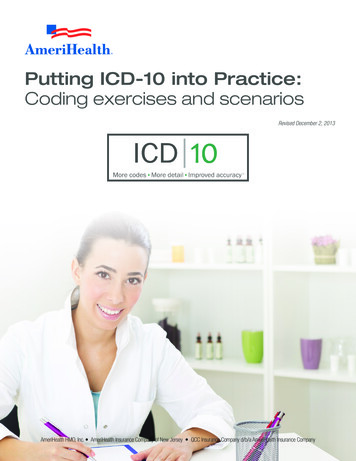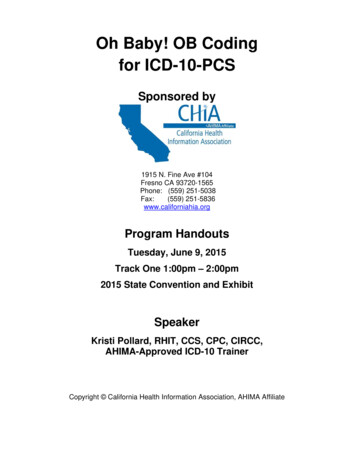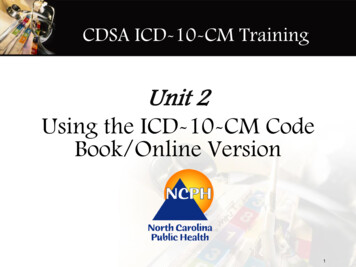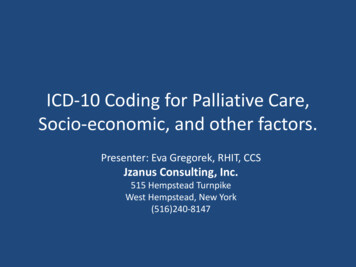
Transcription
ICD-10 Coding for Palliative Care,Socio-economic, and other factors.Presenter: Eva Gregorek, RHIT, CCSJzanus Consulting, Inc.515 Hempstead TurnpikeWest Hempstead, New York(516)240-8147
DISCLAIMERJzanus Consulting, Inc. believes the information is asauthoritative and accurate as is reasonably possibleand that the sources of information used inpreparation are reliable, but no assurance orwarranty of completeness or accuracy is intended orgiven, and all warranties of any type are disclaimed.The information contained in this presentation is ageneral summary that explains certain aspects ofICD-10 coding but is not a legal document.5/18/2016Jzanus Consulting, Inc.2
Objectives Understand the uses of coded data Recognize the importance of physiciandocumentation The use of “Z-codes” to accurately representthe clinical picture of the patient5/18/2016Jzanus Consulting, Inc.3
Uses of Coded Data Exchange meaningful health data with otherorganizations and government agencies Evaluate resource utilization Track public health threats (E.g., avian flu, Ebola) Measure quality of care Accurate reimbursement Assist with advocacy work for healthcare policymatters5/18/2016Jzanus Consulting, Inc.4
Benefits of complete coding Supports the necessity of treatments andservices. Complete coding should be performedregardless of impact on reimbursement.5/18/2016Jzanus Consulting, Inc.5
Clinical Representation of the PatientGood documentation and coding paints an accurate clinicalpicture of the patient.5/18/2016Jzanus Consulting, Inc.6
Palliative Care Care given to improve the quality of life ofpatients who have serious or life-threateningdisease. The goal is to prevent or treat as soon as possiblethe symptoms and side effects of the disease andits treatment. Addresses related issues of psychological, social,and spiritual problems. Referred to as: comfort care, supportive care,and symptom management. Can still receive active treatment.5/18/2016Jzanus Consulting, Inc.7
Palliative Care Palliative care is delivered in variety ofhealthcare settings.– Physician office– Long term care hospital– Skilled nursing facility– Home– Acute care hospital5/18/2016Jzanus Consulting, Inc.8
Palliative Care Documentation Code assignment can only be based on physiciandocumentation. Accurate documentation is needed to reflect the utilization ofresources, acuity of patient care provided and the accuracy ofresearch and quality reporting. The provider documentation in the medical record must clearlystate whether palliative care is being given. The provider documentation should indicate if the admission isfor palliative care or for treatment of an acute condition.5/18/2016Jzanus Consulting, Inc.9
Palliative Care Documentation The documentation should support why the levelof care is necessary. Providers also need to document the acute andchronic medical diagnoses under treatment. Suchas:––––5/18/2016COPDAcute on Chronic Diastolic Congestive Heart FailureAcute Hypoxic Respiratory failureAcute Renal Failure/Acute Tubular NecrosisJzanus Consulting, Inc.10
Palliative Care Documentation Physicians need to be specific whendocumenting a condition– Location– Laterality– Severity/Stage– Type– Status – current/active vs history/resolved– Causal relationships11
Documentation ImpactBullet points of admission Payer -Medicare Discharge Diagnosis – Acuteon Chronic Diastolic CHF Receiving palliative care The physician documentedhx of CVA w/left sideresiduals.Result of Documentation MS-DRG 293 Average LOS 3.1 Geometric LOS 2.6 Reimbursement 510012
Documentation ImpactBullet points of admission Payer -Medicare Discharge Diagnosis – Acuteon Chronic Diastolic CHF Receiving palliative care The physician documents hxof CVA with hemiparesis ofleft side.Result of Documentation MS-DRG 292Average LOS 4.5Geometric LOS 3.7Reimbursement 730013
Factors Influencing Health Status andContact with Health Services The “Z-Codes”– V-Codes in ICD-9 Part of the classification in ICD-10– Supplemental classification in ICD-9 These codes are used to capture a status orproblem impacting the patient that is otherthan a disease or external cause. They are used in conjunction with otherdiagnosis codes.5/18/2016Jzanus Consulting, Inc.14
Factors Influencing Health Status andContact with Health ServicesZ00 – Z13 Health services for examsZ14 – Z15 Genetic carrier and geneticsusceptibility to diseaseZ16 Resistance to antimicrobial drugsZ17 Estrogen receptor statusZ18 Retained foreign body fragmentsZ20 – Z28 Potential health hazards related tocommunicable diseases5/18/2016Jzanus Consulting, Inc.15
Factors Influencing Health Status andContact with Health ServicesZ30 – Z39 Health services in circumstancesrelated to reproductionZ40 – Z53 Encounters for other specificaftercareZ55 – Z65 Potential health hazards related tosocioeconomic and psychosocial circumstancesZ66 Do not resuscitate5/18/2016Jzanus Consulting, Inc.16
Factors Influencing Health Status andContact with Health ServicesZ67 Blood typeZ68 Body mass indexZ69 – Z76 Health services in othercircumstancesZ77 – Z99 Potential health hazards related tofamily and personal history and certainconditions influencing health status5/18/2016Jzanus Consulting, Inc.17
Factors Influencing Health Status andContact with Health Services Z codes are for use in any healthcare setting. May be used as either a first-listed (principaldiagnosis code in the inpatient setting) orsecondary code, depending on thecircumstances of the encounter andguidelines/instructions for specific codes. Certain Z codes may only be used as first-listedor principal diagnosis and some may never beassigned as the principal.5/18/2016Jzanus Consulting, Inc.18
Factors Influencing Health Status andContact with Health ServicesThe ICD-10-CM code book describes the two main reasons forthese use of this code set“When a person who may or may not be sick encounters thehealth services for some specific purpose, such as to receivelimited care or service for a current condition, to donate anorgan or tissue, to receive prophylactic vaccination(immunization), or to discuss a problem which is in itself not adisease or injury.”OR“When some circumstance or problem is present whichinfluences the person's health status but is not in itself a currentillness or injury.”5/18/2016Jzanus Consulting, Inc.19
Factors Influencing Health Status andContact with Health Services These codes provide additional information about the– Status of a condition/disease process Do not use if there is an assigned diagnosis code thatincludes the status For example, code Z94.1, Heart transplant status,should not be used with a code from subcategoryT86.2, Complications of heart transplant.– Socio-economic issues– Reason for readmission– Other issues that can impact patient treatment andoutcomes5/18/2016Jzanus Consulting, Inc.20
Factors Influencing Health Status andContact with Health Services Reliant on the physician’s documentation Supported by ancillary documentation In some cases these codes can impact reimbursement5/18/2016Jzanus Consulting, Inc.21
Factors Influencing Health Status andContact with Health ServicesThese codes must meet the criteria as aPrincipalORSecondary/additional diagnosisin order to be coded5/18/2016Jzanus Consulting, Inc.22
Secondary Diagnosis CriteriaAcute Care/Long Term Care/HomeHealth/Rehab/SNFClinical evaluation; orTherapeutic treatment; orDiagnostic procedures; orExtended length of stay; orIncreased nursing careand/or monitoring5/18/2016Jzanus Consulting, Inc.OutpatientReason for servicesChronic conditionsCo-existing conditions23
Encounters for Other SpecificHealthcareZ40-Z535/18/2016Jzanus Consulting, Inc.24
Palliative CareZ51.5 (ICD-10) – encounter for palliative care– Instruction for category Z51 state to code alsocondition requiring careCompare toV66.7 (ICD-9) – encounter for palliative care– Instruction for code V66.7 state to code firstunderlying disease5/18/2016Jzanus Consulting, Inc.25
Palliative Care Gives the impression that Z51.5 should be theprincipal diagnosis. Medicare Code Editor V33 effective October 1,2015 states otherwise.– Code Z51.5 is an unacceptable principal diagnosisfor inpatient admission5/18/2016Jzanus Consulting, Inc.26
Palliative Care Possible sequencing guidance– The American Hospital Association publishes CodingClinic for ICD-10-CM– The AHA has decision making in it’s pipeline regardingthe sequencing of code Z51.5– No official decision at this time Consideration is to allow code Z51.5 as the principaldiagnosis depending on the reason for admission– Documentation will be even more important. May have claim submission implications Keep your eyes open for this guidance May need to work with payers5/18/2016Jzanus Consulting, Inc.27
Attention to Artificial Openings Use category Z43 when routine care,adjustment, or fitting is performed on anartificial opening. This is more than status– Status merely indicates that an artificial opening ispresent.– It is important that documentation indicate if careis directed towards the opening or if it is selfmaintained.5/18/2016Jzanus Consulting, Inc.28
Attention to Artificial Openings Z43.0 - Encounter for attention to tracheostomyZ43.1 - Encounter for attention to gastrostomyZ43.2 - Encounter for attention to ileostomyZ43.3 - for attention to colostomyZ43.4 - Encounter for attention to other artificial openingsof digestive tractZ43.5 - Encounter for attention to cystostomyZ43.6 - Encounter for attention to other artificial openingsof urinary tractZ43.7 - Encounter for attention to artificial vaginaZ43.8 - Encounter for attention to other artificial openingsZ43.9 - Encounter for attention to unspecified artificialopening5/18/2016Jzanus Consulting, Inc.29
Potential health hazards related tosocioeconomic and psychosocial issuesZ55 – Z655/18/2016Jzanus Consulting, Inc.30
Socioeconomic Issues The link between socio-economic status andhealth issues is constantly under review andlinks have been established between theseissues and disease management. Coded data provides information for research. Provides information to explain issues withthe patient’s disease process or treatment.5/18/2016Jzanus Consulting, Inc.31
History of Abuse and NeglectZ62.810 - Personal history of physical and sexualabuse in childhoodZ62.811 - Personal history of psychologicalabuse in childhoodZ62.812 - Personal history of neglect inchildhoodZ62.819 - Personal history of unspecified abusein childhood5/18/2016Jzanus Consulting, Inc.32
Family IssuesZ62.820 - Parent-biological child conflictZ62.821 - Parent-adopted child conflictZ62.822 - Parent-foster child conflictZ62.890 - Parent-child estrangement NECZ63.0 - Problems in relationship with spouse orpartnerZ63.1- Problems in relationship with in-lawsZ63.31 - Absence of family member due to militarydeploymentZ63.32 - Other absence of family member5/18/2016Jzanus Consulting, Inc.33
Family IssuesZ63.4 - Disappearance and death of familymemberZ63.5 - Disruption of family by separation anddivorceZ63.6 - Dependent relative needing care at homeZ63.71 - Stress on family due to return of familymember from military deploymentZ63.72 - Alcoholism and drug addiction in familyZ63.79 - Other stressful life events affecting familyand household5/18/2016Jzanus Consulting, Inc.34
Housing and Resource ProblemsZ59.0 - HomelessnessZ59.1 - Inadequate housing––––Lack of heatingRestriction of spaceTechnical defects in home preventing adequate careUnsatisfactory surroundingsZ59.2 - Discord with neighbors, lodgers andlandlordZ59.4 - Lack of adequate food and safe drinkingwater5/18/2016Jzanus Consulting, Inc.35
Housing and Resource ProblemsZ59.5 - Extreme povertyZ59.6 - Low incomeZ59.7 - Insufficient social insurance and welfare supportZ59.8 - Other problems related to housing and economiccircumstances– Foreclosure on loan– Isolated dwelling– Problems with creditorsZ59.9 - Problem related to housing and economiccircumstances, unspecifiedZ60.2 - Problems related to living alone5/18/2016Jzanus Consulting, Inc.36
Do Not ResuscitateZ665/18/2016Jzanus Consulting, Inc.37
Do Not Resuscitate Per the ICD-10 Official Coding Guidelines codeZ66 may be used when it is documented bythe provider that a patient has a do notresuscitate status at any time during the stay.5/18/2016Jzanus Consulting, Inc.38
Body MassZ685/18/2016Jzanus Consulting, Inc.39
Body Mass Index The body mass index (BMI)should be coded whenthere is a weight related issue. The weight related issue such as obesity,cachexia, malnutrition is also coded.– The physician must document the diagnosisassociated with low or high BMI. The BMI can be obtained from ancillarydocumentation such as nursing or nutritionist. Separate pediatric (under 21) BMI based ongrowth charts.5/18/2016Jzanus Consulting, Inc.40
Body Mass Index 30-Body mass index (BMI) 30.0-30.9, adultZ68.31-Body mass index (BMI) 31.0-31.9, adultZ68.32-Body mass index (BMI) 32.0-32.9, adultZ68.33-Body mass index (BMI) 33.0-33.9, adultZ68.34-Body mass index (BMI) 34.0-34.9, adultZ68.35-Body mass index (BMI) 35.0-35.9, adultZ68.36-Body mass index (BMI) 36.0-36.9, adultZ68.37-Body mass index (BMI) 37.0-37.9, adultZ68.38-Body mass index (BMI) 38.0-38.9, adultZ68.39-Body mass index (BMI) 39.0-39.9, adultJzanus Consulting, Inc.41
Body Mass Index Morbid Obesity– Z68.41- Body mass index (BMI) 40.0-44.9, adult– Z68.42 - Body mass index (BMI) 45.0-49.9, adult– Z68.43 - Body mass index (BMI) 50-59.9 , adult– Z68.44 - Body mass index (BMI) 60.0-69.9, adult– Z68.45 - Body mass index (BMI) 70 or greater,adult5/18/2016Jzanus Consulting, Inc.42
Body Mass Index Low weight issues: i.e. underweight, cachexia,malnutrition, anorexia– Z68.1 - Body mass index (BMI) 19 or less, adult Use for BMI under 19 and from 19 – 19.95/18/2016Jzanus Consulting, Inc.43
5/18/2016Jzanus Consulting, Inc.44
5/18/2016Jzanus Consulting, Inc.45
Resistance to antimicrobial drugsZ165/18/2016Jzanus Consulting, Inc.46
Resistance to Antibiotics Used as an additional code for antibiotic resistantinfections. The infection is coded first. Also code the organism.– MRSA and MSSA are each combined into the organismcode– B95.61 Methicillin susceptible Staphylococcusaureus infection as the cause of diseases classifiedelsewhere– B95.62 Methicillin resistant Staphylococcus aureusinfection as the cause of diseases classifiedelsewhereSummer 2015 2015 Jzanus Consulting, Inc.47
Resistance toother agentsSummer 2015 2015 Jzanus Consulting, Inc.48
Resistance to AntibioticsExample 78 year old woman was found to have a UTIwith ESBL E. Coli. Assign codes– N39.0 – urinary tract infection– B96.20 – escherichia coli– Z16.12 - extended spectrum beta lactamase (ESBL)resistanceSummer 2015 2015 Jzanus Consulting, Inc.49
Health Service in Other CircumstancesZ69-Z765/18/2016Jzanus Consulting, Inc.50
Care dependency These codes are used to describe issues suchas:– Confinement– Difficulties accessing another level of care– Need for relief care5/18/2016Jzanus Consulting, Inc.51
Care dependencyZ74.01 - Bed confinement statusZ74.09 - Other reduced mobilityZ74.1 - Need for assistance with personal careZ74.2 - Need for assistance at home and no other householdmember able to render careZ74.3 - Need for continuous supervisionZ74.8 - Other problems related to care provider dependencyZ74.9 - Problem related to care provider dependency,unspecifiedZ75.0 - Medical services not available in home5/18/2016Jzanus Consulting, Inc.52
Care dependencyZ75.1 - Person awaiting admission to adequate facility elsewhereZ75.2 - Other waiting period for investigation and treatmentZ75.3 - Unavailability and inaccessibility of health-care facilitiesZ75.4 - Unavailability and inaccessibility of other helpingagenciesZ75.5 - Holiday relief careZ75.8 - Other problems related to medical facilities and otherhealth careZ75.9 - Unspecified problem related to medical facilities andother health care5/18/2016Jzanus Consulting, Inc.53
Potential Health Hazards Related toFamily and Personal History andCertain Conditions InfluencingHealth StatusZ77 – Z995/18/2016Jzanus Consulting, Inc.54
Personal History ofMalignant Neoplasm Category Z85 is used when a primary malignancyhas been previously excised or eradicated from itssite and there is no further treatment directed tothat site and there is no evidence of any existingprimary malignancy. Extension, invasion, or metastasis to another siteis coded as a secondary malignant neoplasm tothat site. The secondary site may be the principalor first-listed with the Z85 code used as asecondary code.5/18/2016Jzanus Consulting, Inc.55
Personal History ofMalignant NeoplasmZ85.01 - Personal history of malignant neoplasm ofesophagusZ85.020 - Personal history of malignant carcinoidtumor of stomachZ85.028 - Personal history of other malignantneoplasm of stomachZ85.030 - Personal history of malignant carcinoidtumor of large intestineZ85.038 - Personal history of other malignantneoplasm of large intestine5/18/2016Jzanus Consulting, Inc.56
Example - Personal History ofMalignant Neoplasm A 64 year old female with history of breastcancer. Patient had a mastectomy andchemotherapy with eradication of the primarysite. Now found to have spread to intraabdominal lymph nodes and bone. C77.2 Secondary malignant neoplasm of intraabdominal lymph nodes C79.51 – Secondary malignant neoplasm of bone Z85.3 Personal history of malignant neoplasm of breast5/18/2016Jzanus Consulting, Inc.57
Presence of Devices There are a multitude of codes in categoriesZ95 – Z97 for devices placed in a patient.– Cardiac– Orthopedic– Nervous system– Many others Not used for complications.5/18/2016Jzanus Consulting, Inc.58
Heart Devices Z95.810 - Presence of automatic (implantable) cardiacdefibrillator Z95.811 - Presence of heart assist device Z95.812 - Presence of fully implantable artificial heart Z95.818 - Presence of other cardiac implants and grafts Z95.820 - Peripheral vascular angioplasty status withimplants and grafts Z95.828 - Presence of other vascular implants andgrafts5/18/2016Jzanus Consulting, Inc.59
Heart Devices Z95.2 - Presence of prosthetic heart valve Z95.3 - Presence of xenogenic heart valve Z95.4 - Presence of other heart-valvereplacement Z95.5 - Presence of coronary angioplastyimplant and graft5/18/2016Jzanus Consulting, Inc.60
Dependence on Medical Devices These codes are used to indicate that thepatient requires certain external devices inorder to manage a disease.5/18/2016Jzanus Consulting, Inc.61
Dependence on Medical DevicesZ99.0 - Dependence on aspiratorZ99.11 - Dependence on respirator [ventilator] statusZ99.12 - Encounter for respirator [ventilator] dependenceduring power failureZ99.2 - Dependence on renal dialysisZ99.3 - Dependence on wheelchairZ99.8 - Dependence on other enabling machines anddevicesZ99.81 - Dependence on supplemental oxygenZ99.89 - Dependence on other enabling machines anddevices5/18/2016Jzanus Consulting, Inc.62
5/18/2016Jzanus Consulting, Inc.63
5/18/2016Jzanus Consulting, Inc.64
Organ Status ICD-10-CM provides codes that describecertain organ status’ such as:– Transplant– Absence5/18/2016Jzanus Consulting, Inc.65
Transplant Status Z94.0 - Kidney transplant statusZ94.1 - Heart transplant statusZ94.2 - Lung transplant statusZ94.3 - Heart and lungs transplant statusZ94.4 - Liver transplant statusZ94.5 - Skin transplant statusZ94.6 - Bone transplant statusZ94.7 - Corneal transplant statusZ94.81 - Bone marrow transplant statusZ94.82 - Intestine transplant statusZ94.83 - Pancreas transplant statusZ94.84 - Stem cells transplant statusZ94.89 - Other transplanted organ and tissue statusZ94.9 - Transplanted organ and tissue status, unspecified5/18/2016Jzanus Consulting, Inc.66
Absence of an Organ Z89.511 - Acquired absence of right leg belowknee Z89.512 - Acquired absence of left leg belowknee Z89.611 - Acquired absence of right leg aboveknee Z89.612 - Acquired absence of left leg aboveknee5/18/2016Jzanus Consulting, Inc.67
Absence of an Organ Z90.410 - Acquired total absence of pancreas Z90.411 - Acquired partial absence ofpancreas Z90.49 - Acquired absence of other specifiedparts of digestive tract Z90.5 - Acquired absence of kidney5/18/2016Jzanus Consulting, Inc.68
Presence of Artificial Openings Assign these codes to indicate that the patient has anartificial opening not requiring 93.0 - Tracheostomy statusZ93.1 - Gastrostomy statusZ93.2 - Ileostomy statusZ93.3 - Colostomy statusZ93.4 - Other artificial openings of gastrointestinal tract statusZ93.50 - Unspecified cystostomy statusZ93.51 - Cutaneous-vesicostomy statusZ93.52 - Appendico-vesicostomy statusZ93.59 - Other cystostomy statusZ93.6 - Other artificial openings of urinary tract statusZ93.8- Other artificial opening statusZ93.9 - Artificial opening status, unspecifiedJzanus Consulting, Inc.69
Long-term Use of Medication Category Z79 is used to indicate that thepatient is being treated with medications on along-term basis. The status is not used for toxic or adverseeffects of a drug.5/18/2016Jzanus Consulting, Inc.70
Long-term Use of Medication Do not assign a code from category Z79 formedication being administered for a briefperiod of time to treat an acute illness orinjury (such as a course of antibiotics to treatacute bronchitis).ICD-10-CM Guidelines5/18/2016Jzanus Consulting, Inc.71
Long-term Use of Medication Z79.01 - Long term (current) use of anticoagulants Z79.02 - Long term (current) use ofantithrombotics/antiplatelets Z79.1 - Long term (current) use of non-steroidal antiinflammatories (NSAID) Z79.2 - Long term (current) use of antibiotics Z79.3 - Long term (current) use of hormonalcontraceptives Z79.4 - Long term (current) use of insulin Z79.51 - Long term (current) use of inhaled steroids Z79.52 - Long term (current) use of systemic steroids5/18/2016Jzanus Consulting, Inc.72
Non-Compliance Managing a non-compliant patient can bedifficult and can increase resource use. Non-compliance causes readmissions. There are many different reasons for noncompliance. ICD-10-CM provides codes that help describethe reason for non-compliance.5/18/2016Jzanus Consulting, Inc.73
Non-ComplianceZ91.11 - Patient's noncompliance with dietary regimenZ91.120 - Patient's intentional underdosing of medicationregimen due to financial hardshipZ91.128 - Patient's intentional underdosing of medicationregimen for other reasonZ91.130 - Patient's unintentional underdosing of medicationregimen due to age-related debilityZ91.138 - Patient's unintentional underdosing of medicationregimen for other reasonZ91.14 - Patient's other noncompliance with medication regimenZ91.15 - Patient's noncompliance with renal dialysisZ91.19 - Patient's noncompliance with other medical treatmentand regimen5/18/2016Jzanus Consulting, Inc.74
Underdosing New concept with ICD-10 Taking less of a medication than is prescribed by aprovider or a manufacturer's instruction Reason for hospitalization or service will be therelapse of the condition under treatment or thecondition that the underdosing caused Benefit of good supportive documentation– Provides a clear picture for readmissions/revisits5/18/2016Jzanus Consulting, Inc.75
Underdosing The physician must document– The effect on the condition under treatment orthe condition that the underdosing caused– The fact the underdosing occurred– The reason the underdosing happened5/18/2016Jzanus Consulting, Inc.76
Intentional Underdosing Z91.12 Patient's intentional underdosing ofmedication regimen– Z91.120 - Patient's intentional underdosing ofmedication regimen due to financial hardship– Z91.128 - Patient's intentional underdosing ofmedication regimen for other reason5/18/2016Jzanus Consulting, Inc.77
Un-Intentional Underdosing Z91.13- Patient's unintentional underdosing ofmedication regimen– Z91.130 - Patient's unintentional underdosing ofmedication regimen due to age-related debility– Z91.138 - Patient's unintentional underdosing ofmedication regimen for other reason5/18/2016Jzanus Consulting, Inc.78
Unspecified Underdosing Z91.14 Patient's other noncompliance withmedication regimen– Patient's underdosing of medication NOS5/18/2016Jzanus Consulting, Inc.79
Example 1 - UnderdosingA patient is being treated with prednisone for bone painfrom metastatic bone cancer from primary left upper lobelung cancer. The patient abruptly stopped taking themedication, due to forgetfulness from brain metastasis anddeveloped secondary adrenal insufficiency.E27.40 - Adrenocortical insufficiencyT38.0X6A - Underdosing of glucocorticoids and syntheticanaloguesZ91.138 - Patient's unintentional underdosing of medicationregimen for other reasonAlso code - lung cancer, secondary bone cancer, secondarybrain cancer, neoplasm related pain5/18/2016Jzanus Consulting, Inc.80
Example 2 - UnderdosingA 77 year-old patient is admitted with acute on chronicdiastolic CHF. The physician documents that the exacerbationis because the patient had no money to purchasemedications.I50.33 – Acute on chronic diastolic (congestive) heart failureT50.1X6A – Underdosing of loop (high-ceiling) diuretics,initial encounterZ91.120 - Patient's intentional underdosing of medicationregimen due to financial hardship5/18/2016Jzanus Consulting, Inc.81
Conclusion There is benefit to taking the “extra step” incoding.– Provides a complete clinical picture.– Can help explain outcomes, readmission, andresource use.– Provides data for research an advocacy.5/18/2016Jzanus Consulting, Inc.82
Resources ICD-10 –CM Official Coding Guidelines American Hospital Association Coding Clinic National Institurte of Health;National Cancer Institute-What is PalliativeCare New England Journal of Medicine 2015 373;747-755;Palliaative Care forthe Seriously Ill;Amy KelleyM.D. and R. Sean Morrison, M.D. ;August 20,2015 J Gen Intern Med. 2003 Oct; 18(10): 864–870. doi: 1046/j.15251497.2003.20918.x PMCID: PMC1494926 The Long-term Health Outcomesof Childhood Abuse - An Overview and a Call to Action; Kristn Springer,MPH, MA; Jennifer Sheridan, PhD; Daphne Kua, PhD; Molly Carnes, MD,MS Robert Wood Johnson Foundation5/18/2016Jzanus Consulting, Inc.83
Questions?Thank you!5/18/2016Jzanus Consulting, Inc.84
ICD-10 coding but is not a legal document. 5/18/2016 Jzanus Consulting, Inc. 2 . Objectives Understand the uses of coded data Recognize the importance of physician documentation The use of "Z-codes" to accurately represent the clinical picture of the patient
